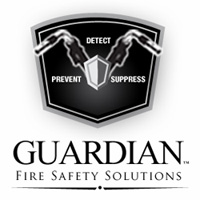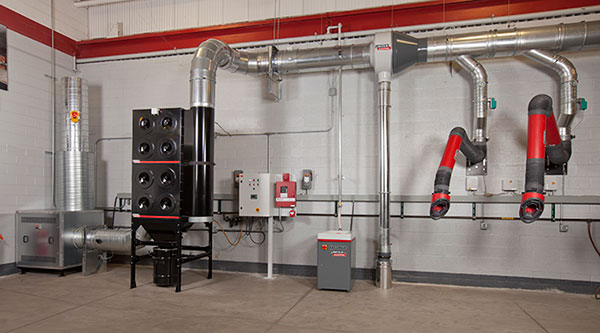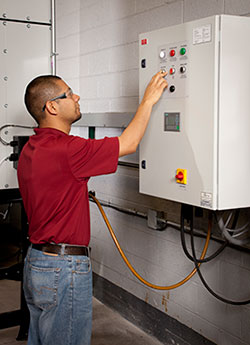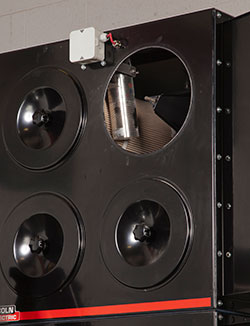Fire Risks in Fume Extraction Systems: What You Should Know and How to Prevent It
by Christopher Brodnick and Jason Lange
Fire can present a serious risk in manufacturing facilities, particularly in metalworking and fabricating applications. In any shop, welding and cutting operations have the potential to trigger a blaze if proper precautions are not followed. From filter fires to spontaneous combustion flares in dustbins, hazards exist throughout the shop floor.
When a fire ignites in a manufacturing environment, a lot of things happen quickly. You have to shut down your production line, evacuate the building for safety and have either your in-house firefighting team or the local fire department investigate the incident. That’s a best-case scenario.
Most fires in a manufacturing facility start in a small area and spread quickly. One potential source of these types of fire outbreaks is the filters in your fume extraction system. Fire can be a serious risk in these systems because it can occur unexpectedly and can cause not only equipment damage but may result in a fire in your facility which can involve the risk of injury to workers. The thing to remember is that these kinds of fires can, and most likely will, occur in your facility at some point, even if you are careful and follow proper procedures.
An unmanaged fire can be costly and, worse, dangerous. If and when a fire occurs, companies can incur large capital and operational costs from downtime on damaged systems and lead times required to repair or replace this equipment. These costs don’t even include the most crucial factor - the human element. Any major fire has the potential to put workers - the most important resource a company has - at risk.

View Guardian™ Fire Safety Solutions Products
It’s crucial to build a targeted, first-line of defense in advance. First, include fire prevention and readiness training and procedures in your overall safety plan. It’s just as important as wearing proper personal protection equipment, meeting OSHA standards and avoiding lost-time accidents.
Next, be sure to properly control welding and cutting processes with fume extraction systems, by capturing sparks and preforming proper equipment maintenance. You also can add an extra line of defense on the shop floor by specifying and installing a custom fire safety solution to reduce the risk of fire in extraction system filters. Featuring components that can prevent, detect and suppress fires in any metalworking facility, these systems can minimize fire hazards, limit system damage and help mitigate the risk of fire escalation and accumulation of smoke throughout the manufacturing environment.

What causes filter fires?
Three key elements – fuel, oxygen and heat – are necessary for a fire to start and to keep it burning. Fuel (any combustible substance) can accumulate as a mixture of particulates those that may be in welding fume and oil in the ductwork or in the filter itself. A source of oxygen, which is necessary to support a fire, enters the system through the extraction power of the fan. The heat component comes from such potential sources of ignition as sparks, smoldering or burning particles (which can include cigarette butts) or spontaneous combustion.
Simply put, anytime you have a spark, heat and oxygen near a filter system, you run the risk of a smoldering fire or spontaneous combustion within the system. Some welding and cutting applications, however, pose a higher risk of this than others. Contributing factors include the following:
- Amount of oil or other flammable materials on the work.
- High temperatures.
- Excessive spatter.
- Low flashpoint of oil or other involved substances.
Manual, robotic and automated welding of oily parts or products, in general, can present distinct fire hazards in any shop. It’s easy to underestimate fume extraction system maintenance in such applications. Oily welding fumes pose a serious risk by reducing filter life and causing increased maintenance costs. And, in these kinds of environments, fires can break out in fume extraction systems even years after installation.
In robotic welding of pressed, stamped or oily parts, such as in the automotive industry, the process can create welding fumes with a relatively low flashpoint. These fumes can be ignited by sparks or swelter in the dustbin or collection location causing spontaneous combustion.
Cutting tables also can be a culprit. The cutting process produces glowing materials that create possible fire risk. Another area that can present hazards is source extraction, which includes fume extraction arms, often known to be misused for cigarette ash and butt disposal.
Seeking a solution
Fire safety systems, which work in conjunction with existing fume extraction systems, can provide any manufacturing facility with fire detection, prevention and suppression capabilities. Every factory is different, so there’s no such thing as a cookie-cutter, off-the-shelf fire safety system that suits all manufacturing operations. The most effective systems are specified and designed to control fire risk in ways specific to each facilities’ processes and applications.
For example, the Guardian™ fire safety system from Lincoln Electric contains several components that can be combined to create a comprehensive solution. Each product in the line has its own unique role in a system, from reducing the risk of a fire to detecting possible fire starters on the shop floor. Other components can immediately suppress the start of fires, helping to keep system damage to a minimum.
Beyond fire prevention, these systems have ancillary roles in the overall efficient maintenance and operation of the entire fume extraction system. They can help minimize replacement, maintenance and filter downtime in case of fire and also increase the effectiveness and lifespan of the system.
When specifying a fire safety system for your application there are several key factors to consider:
Spark Arrestors: Stopping Fires Before they Start
The first line of fire prevention in fume extraction systems is a spark arrestor. This component starts prevention measures where a fire begins – at the spark.
Sparks are the most common potential ignition source in the metalworking and fabrication industries. Extraction systems without a spark arrestor may be at risk for spatter, sparks and dust reaching the combustible filter cartridge, debris in the dustbin or collection location.
In-line spark arrestors require little or no floor space and provide the ability to remove well-known ignition sources, such as welding and grinding sparks and cigarette butts, from the fume extraction system.
The best of these systems can also be used as a pre-separator for high-dust applications. Centrifugal acceleration removes most sparks from the continuous airflow. A dustbin then collects all the remaining sparks at a safe distance from the main filter and away from the main ductwork. You can easily remove this dustbin to dispose of particulate any time, even during operation.
One thing to keep in mind is the issue of maintenance. Improper maintenance can contribute to fires. And, a spark arrestor, just like any other piece of equipment, requires maintenance. Some spark arrestors, like Lincoln Electric’s Spark Guardian™, are designed with maintenance in mind. Its removable body can be dismantled into sections because it is connected to the ductwork with clamps, providing easy access for cleaning. Additionally, optional inspection hatches can be placed near the unit, making it possible to inspect ductwork to determine whether cleaning is necessary.
The Spark Guardian™ is available to be installed standalone or can be integrated with existing fume control systems. Standalone units can be configured to communicate with a facility’s existing control system through available circuits.


Limestone Feeders: Chemical Fire Protection
But, spark arrestors are not the only prevention component that manufacturers can add to their fume extraction systems. For shops that perform welding on components covered with punching or rust preventive oils, limestone feeders also can provide extra fire protection in these environments. These feeders are particularly suitable for applications involving base metals coated with low-flashpoint oils.
Limestone decreases oil’s combustibility by absorbing oily particulate and other substances. The unit continuously injects limestone into the ductwork to reduce particulate concentrations in the exhausted air. The mixed limestone and oil becomes dry matter. When it reaches the filter, it falls into the dustbin during the cleaning cycle.
Some limestone feeders, such as Lincoln Electric’s Oil Guardian™, feature two agitators – specifically developed and adapted to limestone’s characteristics. These agitators keep the limestone in the hopper and feeder in constant motion, ensuring a steady and uninterrupted limestone feed. If there is a change in pressure in the filter inlet, the feeder stops automatically.
Inexpensive and effective, limestone also helps protect filter cartridges against premature clogging caused by oily particulate. This can help considerably to extend the cartridge lifespan, reducing filter replacement costs – and, in turn, operational costs.
Fire Detection: Catching Problems Early and Quickly
Detection components in fire safety systems are designed to detect a fire in its earliest phases, recognizing the high temperatures, sparks and smoke created from a starting fire. Early detection used with fire suppression systems can reduce damage to the filter system and keep the risk of a serious blaze to a minimum. These detectors are designed to identify fire during system operation and when it is turned off. They are most effective when placed in the filter housing and the ductwork behind the filter.
A fire detection panel, such as Guardian Control™, is an important part of this line of fire safety. If one of the system’s fire detectors is activated, the detection panel takes over, handling the following tasks:
- Switching off the fan to stop the supply of fresh air.
- Closing the pneumatic sliding valves in the ductwork to isolate the fire.
- Shutting down the compressed air supply that’s used for cleaning filter cartridges.
- Venting the cleaning cylinder.
- Activating the system’s fire extinguisher feature.
These actions work together to achieve one major goal – to stop the air supply. Without air, the fire’s expansion is minimized, preventing a larger fire from occurring. This also limits subsequent damage.


Fire Suppression: Stop Fires Fast
If the system detects a fire, it immediately triggers the suppression components. These include sliding valves and aerosol fire extinguishers, which are designed to quickly and reliably suppress the fire. These methods ensure that filter damage is kept to a minimum or eliminated completely by minimizing fire risk and subsequent smoke damage.
In order to be most effective, a suppression system should include sliding isolation valves. The sliding valves serve one purpose: to isolate a fire to a contained location and choke it out early. Should a fire break out, within seconds of detection, the fan shuts off, the filter cleaning system shuts down and the sliding valves isolate the filter by closing it off from the ductwork. This eliminates the air source, which in turn will extinguish the fire. Sliding valves keep the risk of fire, system damage or smoke escaping into the work environment at a minimum.
After the valves have isolated the fire, aerosol fire extinguishers, such as the Flame Guardian™, automatically activate within seconds after the sliding valves close or at temperature climb to 572°F (300°C) These canisters produce an ultra-fine, non-toxic, ozone-neutral aerosol spray that suppresses the fire. The aerosol remains active for at least 30 minutes after initial activation. This prevents re-ignition of the fire.
The compact, self-contained canisters are easy to install in the filter housing and do not require extra air pressure. Another benefit is that the suppression spray will not damage electrical equipment in the way other extinguishing methods might, including water. And, unlike carbon dioxide and Halon gas, this aerosol isn’t harmful when inhaled.
Comprehensive Protection
Fires during welding applications in the metalworking and fabrication industry can be caused in various ways. When combined with proper training and awareness, today’s fire safety systems offer tailor-made protection for any facility.
These systems give manufacturers the ability to specify, design and install a fire safety solution for fume extraction systems that will keep fire risks under control for their specific facility. These tested and certified total system solutions reduce the risk of fire to a minimum, and in the event of a fire, ensure that resulting damage is limited.
Even existing weld fume control systems or larger filtration systems that aren’t typically covered by a standard range of control can be modified to benefit from fire prevention, detection and suppression solutions – designed specifically to meet any facility’s needs. And, in some cases, you might even enjoy insurance discounts or related benefits by having such a system in place. Check with your insurer to verify if they offer such an incentive program.
Don’t Wait For It To Happen To You
Fire is a real threat in any manufacturing facility, particularly in fume extraction system filters. In most cases, it’s not a matter if a fire is going to occur in a filter bank; it’s a matter of when will it occur – and if you are ready for it. A fire, no matter what size, is a serious issue and requires serious solutions for readiness and prevention.
